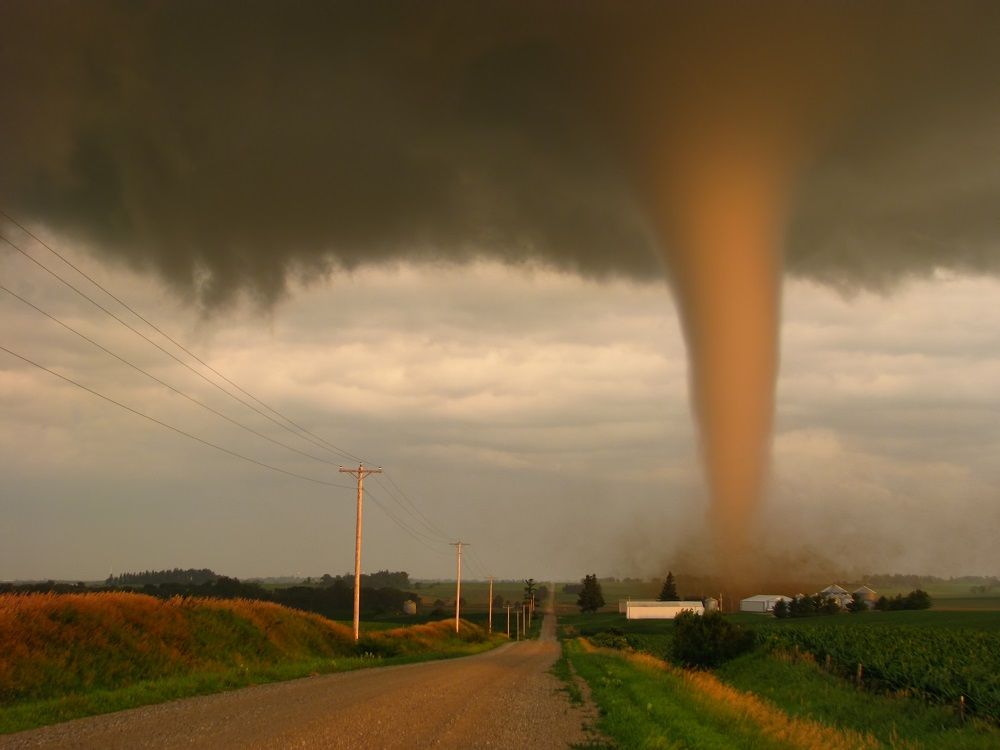
“
Tornadoes, also known as twisters, are fascinating and powerful weather events that capture our attention. A tornado is like a spinning column of air that forms within a cloud and reaches down to touch the ground. Imagine it as an elephant’s trunk made of wind! These swirling funnels can be quite dangerous. Let's learn 20 unique and lesser-known facts about tornadoes.1
1
”
Tornadoes develop during thunderstorms, especially in spring and summer. When warm, humid air collides with cold, dry air, it creates the perfect recipe for a twister, which can cause severe damage and destruction in its path.1
The wind inside a tornado can reach incredible speeds—up to300 miles per hour (480 kilometers per hour). Tornadoes can tear apart buildings, flip trains, and even suck water from riverbeds. They’re like nature’s wild roller coasters. 2
Most tornadoes last only a few minutes, but some can rage for over an hour. But during this short time they can cause harsh destruction. 3
Stretching across the central United States, Tornado Alley earns its name for its frequent tornado occurrences. This region experiences a high concentration of these swirling storms, shaped by unique geographical and meteorological factors. 4

Tornadoes manifest in a spectrum of colors influenced by the debris they engulf. While typically gray or white, they can adopt hues of red, orange, or even ominous black, adding a dramatic visual element to their formidable presence.
Emerging over water bodies, waterspouts are tornadoes' maritime cousins, capable of transitioning ashore or dissipating harmlessly over water. Their formation mirrors terrestrial tornadoes, albeit over aquatic environments. 5
Some tornadoes exhibit a mesmerizing phenomenon known as multiple vortices, featuring smaller whirlwinds orbiting a central core. This complex structure enhances their visual spectacle and amplifies their destructive potential. 6
Accompanied by a distinctive roar likened to a freight train or cascading waterfall, tornadoes announce their presence with an unmistakable auditory signature. This sound emanates from the relentless winds swirling within these atmospheric behemoths. 7
Daring scientists and enthusiasts, known as storm chasers, pursue tornadoes to unlock their mysteries and gather invaluable scientific data. Their adventurous pursuit sheds light on these enigmatic natural phenomena. 8
During intense weather events, tornado outbreaks can unleash multiple tornadoes within a condensed time frame. This meteorological phenomenon underscores the dynamic and unpredictable nature of severe storms. 9
Signs of an impending tornado include an ominous dark, greenish sky, large hailstones, and a distinct roar akin to a jet engine. These atmospheric cues serve as critical warnings for communities in the storm's path. 10
Ensuring safety during a tornado involves seeking refuge in sturdy structures or underground shelters. Avoiding windows and mobile homes mitigates risks, safeguarding against the destructive power of tornadoes. 11
The Tri-State Tornado of 1925 stands as a poignant reminder of tornadoes' devastating potential, holding records for both the longest track length and deadliest impact in U.S. history. Its legacy underscores the enduring impact of severe weather events. 12
Harnessing Doppler radar technology revolutionizes tornado detection by measuring wind velocities and precipitation within storm systems. This advanced meteorological tool enhances early warning systems, bolstering community preparedness. 13
While most prevalent in the United States, tornadoes can occur across every continent except Antarctica. This global distribution highlights their capacity to manifest in diverse climates and geographical settings. 14
Tornadoes defy seasonal boundaries, capable of forming year-round. However, they peak in frequency during spring and early summer when conducive atmospheric conditions converge, fostering their tumultuous birth. 15
With their formidable winds and airborne debris, tornadoes inflict substantial damage on infrastructure, vegetation, and communities in their path. Their aftermath underscores the resilience required for recovery and reconstruction efforts. 16
NASA’s Perseverance rover captured rare footage of a towering “dust devil” dancing across the Martian surface. This dusty vortex is taller than the average U.S. tornado and an impressive five times taller than the Empire State Building. 17
A fire tornado, also known as a “firenado,” is a rare and powerful phenomenon. The first documented fire tornado occurred, moving at around 30 km/h (18.6 mph) and nearly half a kilometre across at its base during its peak. 18
The highest-altitude tornado ever recorded occurred at an elevation of approximately 3,705 meters (12,152 feet) above sea level. This rare event highlights the ability of tornadoes to form in diverse and challenging environments.19


